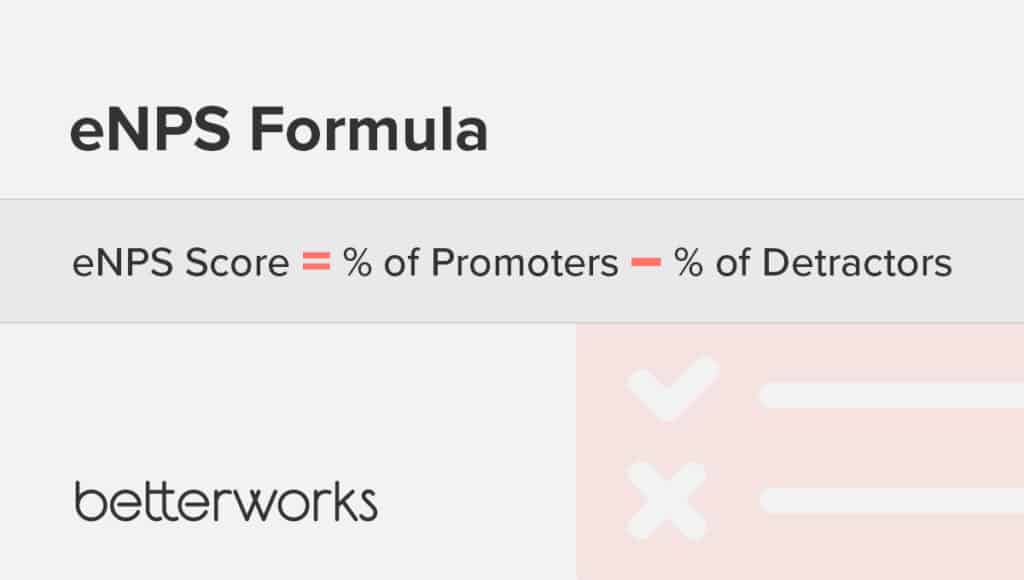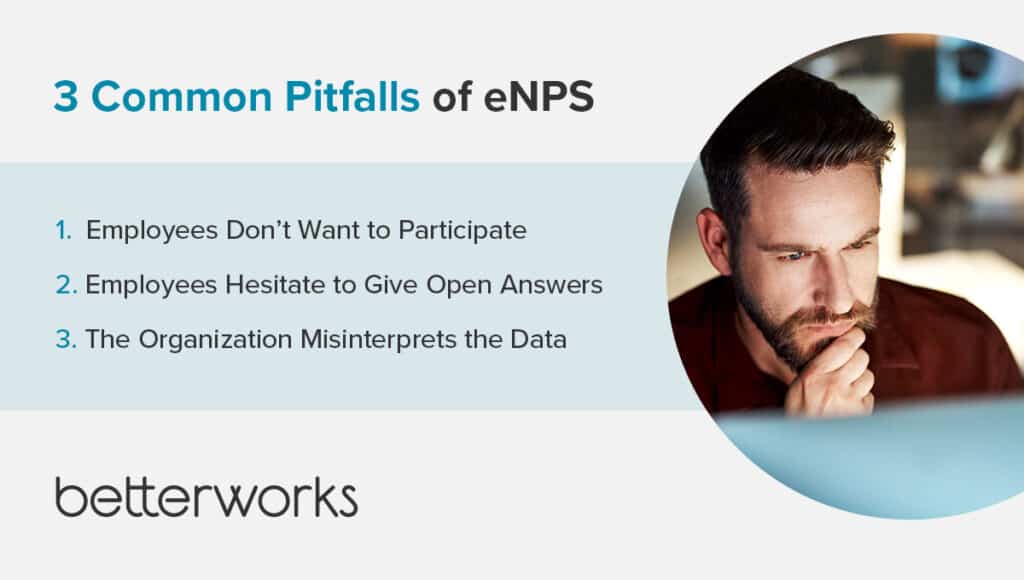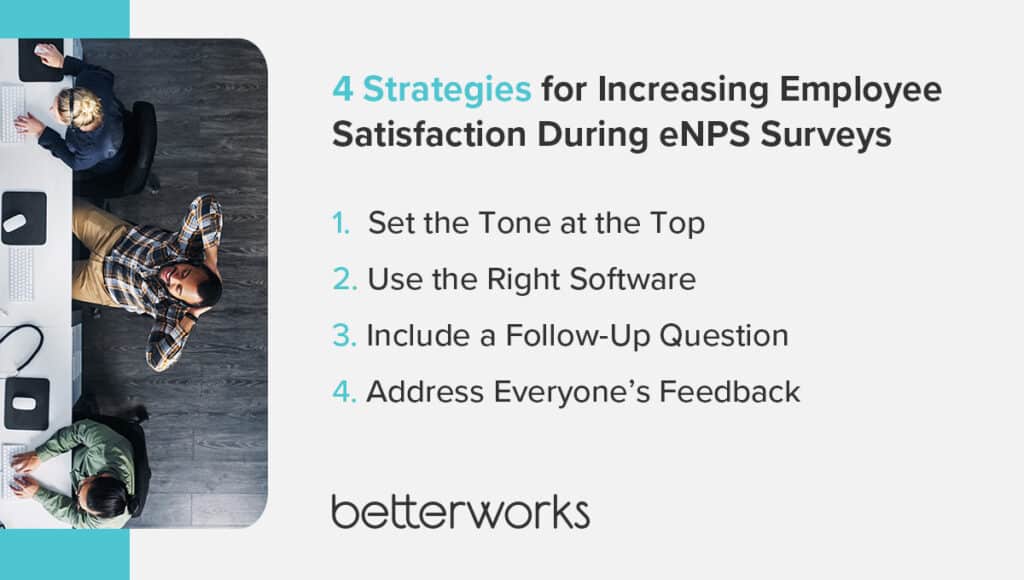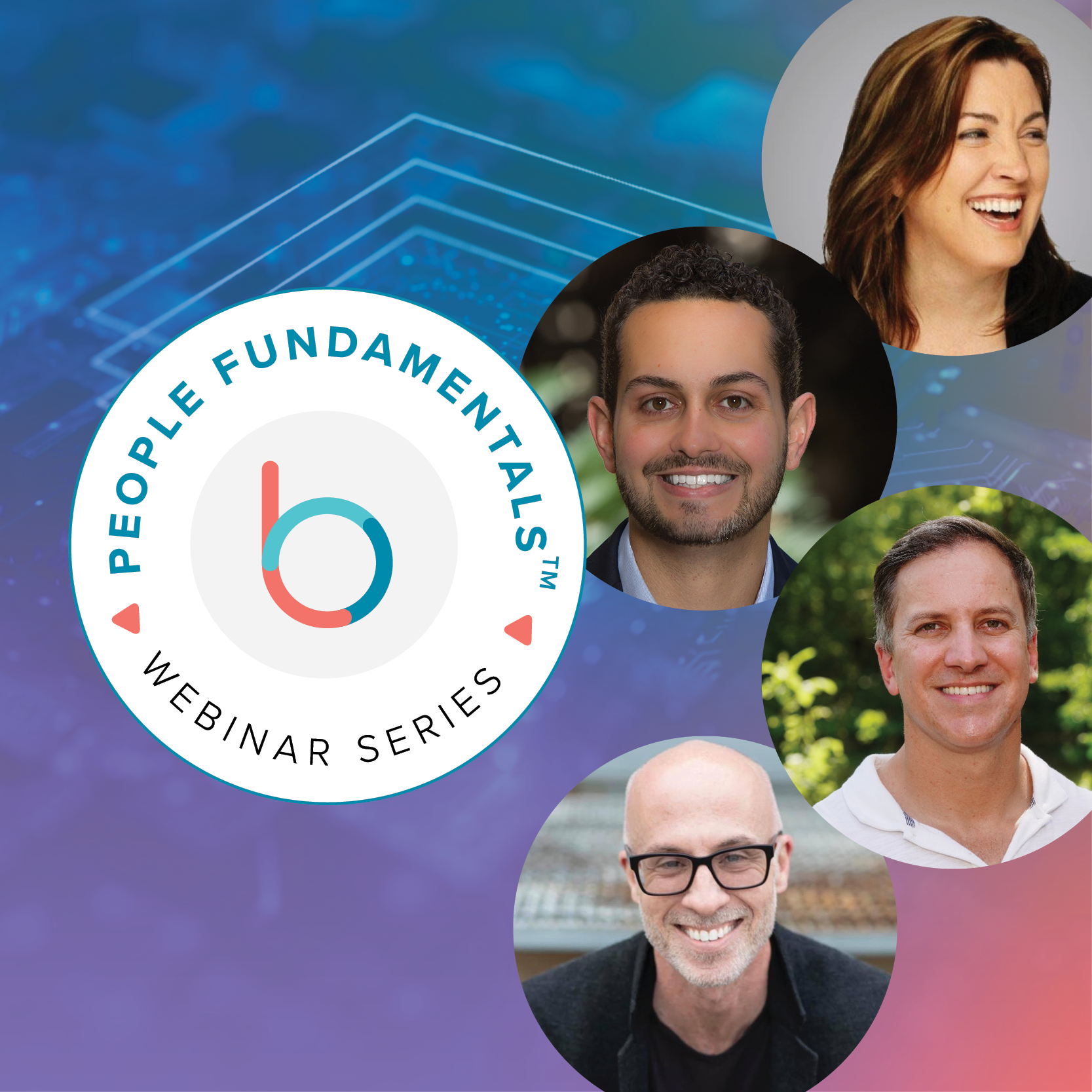- Employee net promoter score: What it is, and why it matters
- How is eNPS different from NPS?
- How can your organization use eNPS to track employee satisfaction?
- Calculating eNPS: How to measure and track your organization’s score
- Common pitfalls of eNPS and how to overcome them
- Improving eNPS: Strategies for increasing employee satisfaction and loyalty
- Use eNPS to improve your organization
HR leaders understand the importance of employee satisfaction and engagement for unlocking workforce growth and potential. But can you get a quick pulse on your workforce without issuing time-consuming and complicated surveys? Employee net promoter score (eNPS) is a powerful metric that reveals how your people are feeling about you.
Whether you’re measuring the success of employee engagement initiatives or starting from scratch, eNPS gives you a straightforward, real-time data point for understanding your organization’s internal reputation.
Learn more about eNPS, how it’s used to track employee satisfaction, and how your organization benefits from using it. We’ll also show you how to calculate and improve your score.
Employee net promoter score: What it is, and why it matters
Employee satisfaction isn’t static. How your employees feel about the organization changes over time based on their experiences, whether they feel valued, and a host of other factors. ENPS offers a simple way to measure employee satisfaction without focus groups or lengthy surveys.
There are two eNPS questions. The main question is some form of “How likely are you to recommend your organization as a place to work (on a scale of 0-10)?” This is followed by an open-ended question asking why the person chose that rating.
ENPS results matter because they tell your organization whether your existing efforts are succeeding. The open-ended responses add insight from employees’ daily experiences that you’d be unlikely to gather otherwise. ENPS results can be acted upon more quickly than other means of measuring employee satisfaction.
As you keep up with HR trends, such as hyper-personalization in employee relationships, eNPS is a powerful component of your employee engagement efforts.
How is eNPS different from NPS?
ENPS is inspired by net promoter score (NPS), the famous customer satisfaction metric. While they have similarities, such as relying on one question and using the same scoring system, they aren’t interchangeable.
The key differences are in the target audience and the question wording. NPS asks a brand’s customers some form of the question “How likely are you to recommend this business?” The responses help businesses understand how customers feel about them. NPS is external-facing and concerned with customer loyalty to the brand. ENPS is internal-facing and gauges employee engagement and satisfaction.
How can your organization use eNPS to track employee satisfaction?
ENPS can be used as a straightforward barometer of employee satisfaction over time when you ask the question regularly. The more data you get, the more you can identify your eNPS baseline and any emerging trends.
This metric offers value by itself because of its simplicity and easily understood calculations, but it also can be a starting point for more expansive exploration of employee satisfaction. For example, if your eNPS score dips after launching a new goal-setting structure, that could prompt you to ask further questions about the employee experience with that process.
ENPS can also help organizations identify training and development needs. If scores are regularly lower for employees in certain job roles, departments, or career tracks, you might cross-check those scores with performance ratings and retention rates. ENPS by itself doesn’t explain your entire culture or tell you what to do, but it can be a powerful starting point for inquiry.
3 benefits of tracking and improving eNPS for organizations
Long-term use of eNPS helps organizations identify the factors that are most important to engaged employees. Here are some of the key benefits of tracking eNPS scores and improving them.
Its simplicity makes it powerful
Most employee engagement surveys ask a long list of questions, sometimes in different ways, all to simply ask whether people are happy at work. Lengthy surveys can be aggravating or confusing for employees to take, and your HR software might not be up to the task.
There’s a human cost to HR, too. Surveys take time to create and administer, and analyzing the results can be complex work — not to mention explaining the implications to leadership.
ENPS gives you high-level, actionable data in very little time. From there, HR leaders can investigate potential employee engagement issues before they get worse.
It’s an easy metric to work with
There’s no algorithm behind eNPS. Everyone gets the same questions and the same range of answers. Everyone in the organization can, at a glance, see the final score and understand whether it’s good and how it’s changed since the last time you surveyed employees.
While eNPS is simple, it’s not inflexible. You can add context to the score with other workforce data. You can use your results to inform the questions you ask on follow-up surveys. You might even combine the two, asking “How likely are you to recommend your organization as a place to work?” as the first question of a longer survey.
Higher participation rate than other surveys
ENPS usually has a higher participation rate than other surveys because of its simplicity and quickness. A longer employee survey can provide tremendous value. But people are busy, and they don’t always trust their organizations enough to answer potentially sensitive or personal questions.
They’re more likely to check in, so to speak, on how they feel about your employer brand with a one-question survey. As they get comfortable with the eNPS process, they’ll be more likely to see the value in other surveys and engagement tactics offered by your employee engagement software.
Calculating eNPS: How to measure and track your organization’s score
To calculate your organization’s eNPS score, you’ll need to survey your employees and group their responses into three categories: Promoters, Passives, and Detractors.
- Promoters are employees who are satisfied with their job and would recommend the company to other people, including friends and family.
- Passives are employees who are generally okay with their job but aren’t particularly enthusiastic or going out of their way to promote you.
- Detractors are dissatisfied employees. They’re candidates to spread negative word of mouth about the company.
The first step is to survey employees and ask them how likely they are to recommend the organization to friends or family. They’ll respond by selecting along a range of zero to 10. The responses are typically broken down into three categories:
- Promoters (9-10 on the scale)
- Passives (7-8 on the scale)
- Detractors (0-6 on the scale)
The next step is to calculate the percentage of employees in each category. This formula is as such:
eNPS Score = % of Promoters – % of Detractors
Promoters are subtracted from detractors to arrive at the organization’s eNPS. For example, if an organization has a promoter percentage of 70%, a passive percentage of 20%, and a detractor percentage of 10%, the eNPS would be 70 minus 10, or 60.
To track your organization’s eNPS score over time, you’ll need to survey employees regularly and average the results.

Common pitfalls of eNPS and how to overcome them
An eNPS is simple, efficient, and straightforward. But it’s not a perfect metric. Here are three common challenges many organizations face — and how you should respond to them.
Employees don’t want to participate
Participation is a common challenge when starting with eNPS, especially if your employees aren’t used to taking surveys or have been bombarded with lengthy, complex surveys.
Employees are reluctant to take surveys for many reasons. They might be overwhelmed with work, worried their responses won’t be anonymous, or they don’t believe their feedback will be heard and acted on.
Earning buy-in requires clear communication from managers to their teams, and making sure the process is easy. Employees should be able to answer the eNPS survey using the same HR software they use for other performance enablement and goal-setting activities. Make sure managers can explain the purpose of eNPS to their teams — including how the organization will use their responses and protect their data.
Employees hesitate to give open answers
The open-ended portion of eNPS can be challenging, as employees might be wary of sharing their honest opinions. They might worry about inadvertently revealing themselves by the details in their answer, or they might believe their response will reflect negatively on them. Other employees might balk at giving detailed feedback because they don’t think management will listen or act.
To overcome this challenge, companies need to make it clear to employees that their feedback is appreciated and accepted without repercussions. If you ask for feedback on a workplace issue, you need to show how you responded.
The organization misinterprets the data
One worry of eNPS and other employee-related data is its misuse or misinterpretation by people in the organization.
To overcome this challenge, companies need to provide training for managers on how to use ENPS data. This training should cover what eNPS measures and what it doesn’t. You don’t want managers to make unfounded assumptions from a single data point, for example. At the senior leadership level, HR leaders need to be clear about eNPS’ value without exaggerating its effects or predictive power.

Improving eNPS: Strategies for increasing employee satisfaction and loyalty
To make sure that organizations are making the most of eNPS, here are four best practices to consider.
Work with senior leaders to set the tone
Every good workforce strategy benefits from high-level buy-in. Senior leaders need to commit to eNPS and provide the public backing and the resources needed to launch. Their day-to-day actions also affect eNPS. Workers aren’t as likely to recommend an employer if they never see or hear from leadership, much less if those leaders are setting a bad example with their words and actions.
Use the right software
How are you surveying employees and tracking their answers over time? Most likely, you’re using your employee engagement software or performance management platform. Make sure whatever eNPS tool you use integrates with your existing systems.
If you can’t view and analyze all workforce data, including eNPS scores, in the same place, you lose the advantage of simplicity.
Include a follow-up question
ENPS is a powerful metric but needs to be supported by additional data. Your initial results can inform you as to what your culture does well and where it’s lagging. Use those insights to generate specific follow-up questions that pinpoint the issues.
Follow-up questions will help you paint a complete picture of employee satisfaction and avoid the pitfall of overrelying on eNPS to explain everything.
Address everyone’s feedback
When you’re looking at the data, it’s important to consider everyone’s feedback, not just the people who had positive things to say. People who have had negative experiences often hold the most valuable insights. By taking everyone’s feedback into account, you can get a more well-rounded view of your company’s eNPS.
You haven’t addressed feedback if all you’re doing is listening. Commit to the hard work of taking negative feedback and figuring out what to do about it. ENPS should activate your HR team to improve employee satisfaction. It shouldn’t be a passive indicator that everyone acknowledges but fails to confront.

Use eNPS to improve your organization
ENPS is a valuable tool for gauging employee satisfaction, identifying areas of improvement, and sparking inquiry. When you combine the simplicity of eNPS, the breadth of other employee engagement measures, and the efforts of your HR team and managers, you can create a working environment that your employees can eagerly recommend to friends and family.
Discover what other metrics you should look to for improving your overall organization and more ways on how to measure employee engagement.







